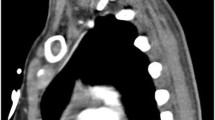Abstract
Eighty-seven patients with pectus excavatum underwent cardiac examination and echocardiography (M-mode) to determine the diagnostic significance of pectus in children for mitral valve prolapse (MVP). Patients’ ages ranged from 1 month to 18 years with a mean age of 5.4 years. Sixty-seven were males. Twenty of the 87 pectus patients (23%) had echocardiographic evidence of MVP, whereas 11 of these had auscultatory findings of a non-ejection click or late systolic murmur, and 4 had significant mitral insufficiency. Fourteen of the 77 patients (18%) with mild pectus, and 6 of the 10 patients (60%) with severe pectus had MVP. Two of the patients (3.4%) with mild pectus and 2 of the patients (20%) with severe pectus also had significant mitral insufficiency. Ten of the 23 patients (44%) older than 8 years of age and 10 of the 64 younger patients (16%) had MVP. Although MVP was present more frequently in females (30%) than in males (21%), the difference was not statistically significant. This study indicates the high incidence of MVP in children of 8 years of age and older, especially when pectus deformity is severe. This information is particularly helpful to heighten suspicion of MVP in children with pectus excavatum.
Similar content being viewed by others
References
Udoshi M, Shah A, Fisher V, Dolgien M. Incidence of mitral valve prolapse in sub-jects with thoracic skeletal abnormalities. A prospective study.Am Heart J 1979; 97: 303–311.
Devereux RB, Kramer-Fox R, Brown WT, Shear MK et al. Relation between clinical features of the mitral prolapse syndrome and echocardiographically documented mitral valve prolapse.J Am Coll Cardiol 1986; 8:763–772.
Jeresaty RM. Mitral valve prolapse. JAMA 1985; No. 6 : 793–795.
Salomon J, Shah PM, Heinle RA. Tho-racic skeletal abnormalities in idiopathic mitral valve prolapse.Am J Cardiol 1975; 36:32.
Bisset GS III, Schwartz DC, Meyer RA et al. Clinical spectrum and long term fol-low-up of isolated mitral valve prolapse in 119 children.Circulation 1980; 62: 423.
Hirschfeld SS, Rudner C, Nash CL et al. Incidence of mitral valve prolapse in ado-lescent scoliosis and thoracic hypokypho-sis. Pediatrics 1982; 70: 451–454.
Devereux RB, Kramer-Fox R, Shear K et al. Diagnosis and classification of severity of mitral valve prolapse.Am Heart J 1987; May : 1265–1278.
Williams RG, Tucker CR. Echocardiogra-phic Diagnosis of Congenital Heart Dis-ease. Boston: Little Brown and Co, 1977; 230.
Warth DC, King ME, Cohen JM et al. Prevalence of mitral valve prolapse in normal children.J Am Coll Cardiol 1985; 5: 1173–1177.
Devereux RB, Perloff JK, Reichek N, Josephson ME. Mitral valve prolapse.Circu-lation 1976; 54:3–14.
McNamara DG. Idiopathic benign mitral leaflet prolapse.Am J Dis Child 1986; 136: 152–156.
Author information
Authors and Affiliations
Rights and permissions
About this article
Cite this article
Park, J.M., Varma, S.K. Pectus excavatum in children : Diagnostic significance for mitral valve prolapse. Indian J Pediatr 57, 219–222 (1990). https://doi.org/10.1007/BF02722092
Issue Date:
DOI: https://doi.org/10.1007/BF02722092




